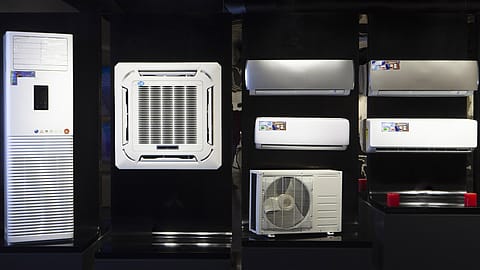Early summer makes Emkay turn bullish on these two AC stocks
The brokerage firm has initiated coverage on the Indian air conditioner (AC) space, with ‘BUY’ on both, Voltas and Blue Star.

The India Meteorological Department (IMD) has forecast above-average temperatures this summer and increase in heat waves, which could potentially boost demand for air cooling products. The domestic brokerage firm Emkay Global believes that this will benefit companies operating in the cooling segment, particularly market leaders Voltas and Blue Star.
The brokerage house has initiated coverage on the Indian air conditioner (AC) space, with ‘BUY’ on both, Voltas and Blue Star. The agency has given a target price of ₹1,600 for Voltas, and ₹2,400 for Blue Star, indicating an upside potential of 23% and 19%, respectively, from current levels.
“We believe the room air conditioner (RAC) category offers the best long-term/secular growth play, led by benign penetration levels (14% vs 208% in China; refer to China Case Study), improving affordability/falling TCOs, rising finance penetration, and improving power availability,” it said in a report.
How Voltas and Blue Star shares performed so far?
On Wednesday, Voltas shares ended 3.3% lower at ₹1,277.10, with a market capitalisation of ₹42,257 crore. The AC stock has delivered a negative return of 3% in the last one year, while it has fallen nearly 29% in six months, and over 30% year-to-date (YTD). The counter touched its 52-week high of ₹1,946.20 on September 20, 2024, while it slipped to its 52-week low of ₹1,135.55 on February 1, 2025.
On the other hand, Blue Star shared ended the day with a loss of 2% at ₹1,936.45 on the BSE, while its market cap slipped to ₹39,816 crore. The stock touched its 52-week high of ₹2,419.95 on January 6, 2025, and is currently down 20% from its peak level. The counter hit its 52-week low of ₹1,345.90 on April 15, 2024. The stock has risen 39% in a year despite losing over 14% in the calendar year 2025. It has fallen nearly 7% in a month.
B Thiagarajan, Managing Director, Bluestar, recently said that India is the fastest growing AC and refrigeration market, with potential to overtake the Chinese AC giant by 2050. “It varies from business to business. I hold the view that India is the fastest-growing market for air conditioning and refrigeration at present. Quite a few studies point out that by 2050, we should overtake even China in terms of market size.”
Recommended Stories
“The room air conditioning segment the penetration is around 7-8% and it is rapidly growing across the country, including tier 3, 4, 5 towns. The growth is visible. The channels are preparing for that kind of growth,” he said.
Will summer 2025 be another record year?
The report notes that summer 2024 appears to have been a pivotal inflexion point, with demand continuing to surge in 2025 versus a broader slowdown across other consumer segments (RAC volume up 30-35% YoY vs 7-10%/3-6% for refrigerators/washing machines in FY25E).
Contrary to fear of supply-chain constraints, the report analysed that industry players are well poised to handle an expected 22% YoY rise in demand in Q4 FY25E and around 16% CAGR over FY25E-27E.
(INR CR)
The report also highlighted that unlike past episodes when few players engaged in price wars, the industry is now exhibiting a more cohesive approach toward price hikes. Several players announced price hikes in Q3 FY25, while price rise is also expected in Q1 FY26, it added.
Scope for AC penetration in longer run
India’s room AC penetration at 14% now (versus China/global average of 208/40-45%), indicates long growth runway for ac makers. The improvement in the AC affordability quotient over the past decade, rising financing penetration, and power availability (power deficit near-zero now vs over 10% till 2012) have made AC products more accessible, as per Emkay report.
The RAC industry, with 45 brands and a long tail of smaller players (top-5 players form 60% of the market), remains highly fragmented. Even market leaders like Voltas continue to operate at a single-digit EBIT margin. Key players (like Blue Star, Daikin, LG, and now Voltas) are scaling up and insourcing production for crucial components like compressors, to enhance product differentiation and strengthen cost structures. While full-scale industry consolidation remains an optionality, its eventual play-out could mirror the trajectory seen in China—where early movers investing in component manufacturing gained a long-term competitive edge.
(DISCLAIMER: The views and opinions expressed by investment experts on fortuneindia.com are either their own or of their organisations, but not necessarily that of fortuneindia.com and its editorial team. Readers are advised to consult certified experts before taking investment decisions.)